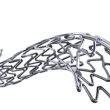Courtesy of Dr. Carlos Fava. The treatment of vein graft lesions has always been difficult in relation to angioplasty, due to their characteristics. While drug-eluting stents (DES) have proven to be superior to bare-metal stents (BMS) for coronary arteries, such superiority is unclear as regards vein grafts. Several studies with first-generation DES (DES1) have even reported<a href="https://solaci.org/en/2017/05/24/second-generation-des-present-lower-mortality-rates-for-vein-grafts/" title="Read more" >...</a>
Plaque protrusion in carotid artery stenting: what are its risks and how can we prevent them?
Courtesy of Dr. Carlos Fava. Carotid artery stenting (CAS) has proven to be effective in high-risk patients. Nowadays, when performed by trained operators, its results are similar to those of surgery. This study seeks to clarify the incidence and prognosis of plaque protrusion through the stent (as observed in both control angiography and intravascular ultrasound [IVUS])<a href="https://solaci.org/en/2017/05/22/plaque-protrusion-in-carotid-artery-stenting-what-are-its-risks-and-how-can-we-prevent-them/" title="Read more" >...</a>
Successful CTO: associated to higher survival rate?
Courtesy of Dr. Carlos Fava. The presence of chronic total occlusions (CTO) in coronary angiograms varies between 5% and 30%, depending of the different analyzis. Likewise, they have been associated to higher mortality rate and the need for myocardial revascularization surgery. The frequency of CTO PCI is low across the different series (3.8%), though<a href="https://solaci.org/en/2017/05/16/successful-cto-associated-to-higher-survival-rate/" title="Read more" >...</a>
Follow-up at 10 years for invasive vs. conservative strategy for non-ST-segment elevation infarction
The ICTUS (Invasive Versus Conservative Treatment in Unstable Coronary Syndromes) trial compared early invasive strategy with a selective invasive strategy in patients with non-ST-segment elevation acute coronary syndrome (NSTE-ACS), with elevated markers such as cardiac troponin T. The absence of long-term benefit of an early invasive strategy at 1 and 5 years had already been reported.<a href="https://solaci.org/en/2017/05/09/follow-up-at-10-years-for-invasive-vs-conservative-strategy-for-non-st-segment-elevation-infarction/" title="Read more" >...</a>
Peripheral artery disease associated to ischemic and bleeding events after DES implantation
Patients with peripheral artery disease (PAD) have higher rates of cardiovascular events after DES implantation, which could be explained partly by higher platelet reactivity. The present work studies the relationship between platelet reactivity and clinical events after PCI in patients with and without a history of peripheral artery disease. The ADAPT-DES study (Assessment of<a href="https://solaci.org/en/2017/04/25/peripheral-artery-disease-associated-to-ischemic-and-bleeding-events-after-des-implantation/" title="Read more" >...</a>
Proximal anterior descending artery angioplasty: what are its long-term outcomes?
Courtesy of Dr. Javier Castro. Certain coronary lesions have been historically discouraged for endovascular treatment. Among these can be found left main coronary artery lesions, multivessel disease, and proximal anterior descending artery lesions. As a matter of fact, the latter is actually considered separately as a criterion for choosing the revascularization method. Endovascular treatment of<a href="https://solaci.org/en/2017/04/20/proximal-anterior-descending-artery-angioplasty-what-are-its-long-term-outcomes/" title="Read more" >...</a>
SYNERGY vs. XIENCE in Complex Real-World Patients
Courtesy of Dr. Guillermo Migliaro. Technological advancements in drug-eluting stents (DES) have shown significant improvement as regards the safety and efficacy of these devices. DES are considered to be the golden standard for the treatment of percutaneous coronary interventions. DES with permanent or durable polymers (DP) have been associated with local inflammatory reactions and<a href="https://solaci.org/en/2017/04/01/synergy-vs-xience-in-complex-real-world-patients/" title="Read more" >...</a>
Left Main Target Lesion Revascularization: When is it Necessary?
Courtesy of Dr. Agustín Vecchia. Incidence, predictors and impact of target lesion revascularization (TLR) on unprotected left main stenosis initially treated with second generation DES have not yet been clearly defined and this is the main goal of the present study. This is a multicenter observational retrospective study of patients with unprotected left main<a href="https://solaci.org/en/2017/03/27/left-main-target-lesion-revascularization-when-is-it-necessary/" title="Read more" >...</a>
Why We Should Use IVUS in Complex Coronary Lesions
Courtesy of Dr. Carlos Fava. Drug eluting stents (DES) have shown benefits in terms of restenosis vs. conventional bare metal stents (BMS). Many of the advantages of DES depend on correct implantation, especially in complex lesions. In complex lesions, the use of intravascular ultrasound (IVUS) provides important information on lesion length, vessel diameter, calcification<a href="https://solaci.org/en/2017/03/20/why-we-should-use-ivus-in-complex-coronary-lesions/" title="Read more" >...</a>
Zotarolimus with Durable Polymer vs. Biolimus with Biodegradable Polymer
The present work compared the safety and efficacy of the permanent polymer zotarolimus eluting stent vs. the biodegradable polymer biolimus eluting stent in unselected coronary artery disease patients. The biodegradable polymer biolimus eluting stent resulted superior to the first generation durable polymer stent in long term randomized studies. However, little evidence supports this superiority<a href="https://solaci.org/en/2017/03/13/zotarolimus-with-durable-polymer-vs-biolimus-with-biodegradable-polymer/" title="Read more" >...</a>









